For us doggy owners, our little furry friends are a part of our family. They’re our “fur babies”! With so many brands and doggy fads popping up over the years, it can be overwhelming and stressful trying to keep up with everything your pet needs so that they’re at the pinnacle of health.
Who knew there were so many components to that, right? From brushing their teeth to feeding them specific brands of probiotics, it’s a hard life out there for dog parents!
What we may not consider is if we’re feeding our dogs more than just the top quality products listed on the back of the bag or can. We could also be feeding them mold.
Over the years, there have been various pet food recalls for brands that had an overabundance of microscopic toxins that mold produces called mycotoxins. ¹ You've probably seem them splashed across the news.
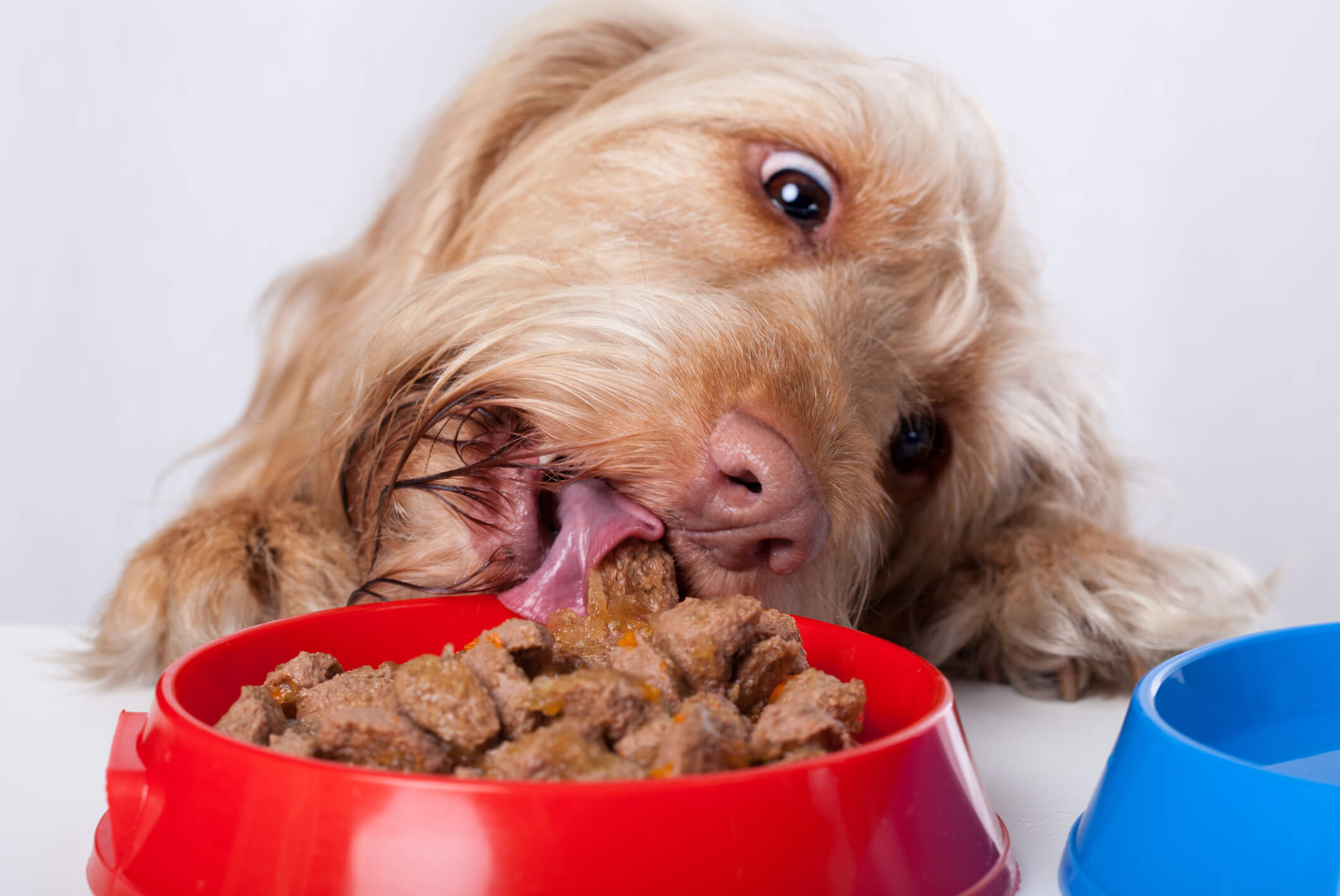
Just this year, the Food and Drug Administration initiated investigations into Midwestern Pet Foods products for potentially causing over 130 pet deaths and over 220 pet illnesses.² They believed the cause of such a tragedy was a high level of aflatoxin, a type of mycotoxin.
They chalked up the cause of such a high level of toxin in the food to improper manufacturing plant practices, saying, “FDA investigators found evidence of significant violations of the Current Good Manufacturing Practice, Hazard Analysis, and Risk-Based Preventive Controls for Food for Animals regulation.”³
This one instance, though, highlights a larger issue for us pet owners: mold in dog food.
What is Mold?
Mold is a type of fungus with over 100,000 species identified so far.⁴ It reproduces by creating microscopic spores, kind of like a weed’s seeds, that it releases into the air.⁵
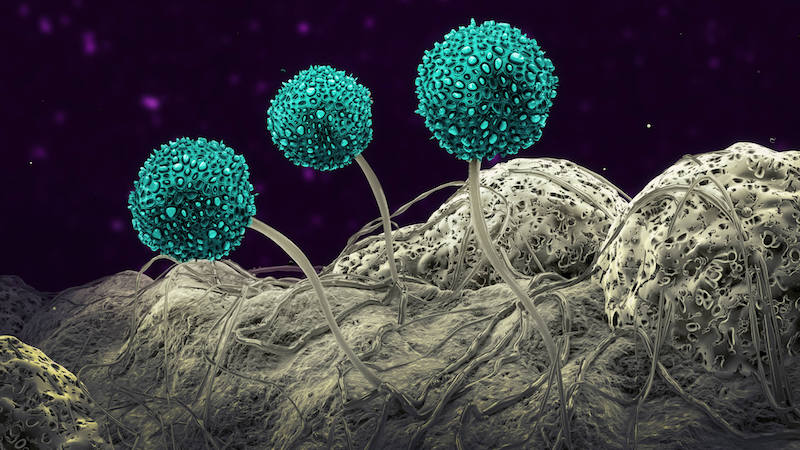
With so many species, it’s safe to say that mold spores are pretty much everywhere; outside in nature, inside of homes, and even on your pet’s fur.
Many mold species can also create mycotoxins, those tiny, invisible toxic particles mentioned periodically in the news.⁶ The issue with mold growth and its related byproducts is when it occurs in places it shouldn't, like indoors or in food products. Unfortunately, indoor mold colonization is fairly easy to accomplish.
Mold is a hardy little fungus. Most mold species only need four key things to survive and thrive:⁷
- Oxygen
- Temperatures between 40-90 degrees Fahrenheit
- Food (they eat almost anything)
- Moisture
Moisture is the elixir of life when it comes to a mold spore finding and creating a happy growing environment. The other three ingredients for growth are fairly easy to obtain. Tack on mold spores’ ability to grow in 24-48 hours and you probably get an idea of how easily mold in dog food can occur.
All it takes is a bit of added moisture.
Mold in Dog Food and Health
Exposure to mold and its byproducts can cause a range of health effects in humans and pets alike.⁸’⁹ While we typically think of exposure as mold growth in a home causing us to inhale a high volume of spores, ingesting mold particles can be just as toxic.
For pets, especially, this can cause serious health symptoms due to their size and immune system. ¹⁰'¹¹’¹²’¹³’¹⁴ When it comes to what exactly they'll experience, it depends on the dog. Just like humans as well, some dog breeds are more susceptible to mold allergies or immune responses than others. While some dogs will only have a runny nose, others will have much more severe reactions. Symptoms they experience also depend on the species of molds, types of mycotoxins, and quantities of both in the food. For instance, high levels of vomitoxin, a mycotoxin, can cause dogs to vomit or reduce their food intake.¹⁵ Which happens to make it incredibly aptly named.
Other mold exposure symptoms can include:
- Excessive licking or scratching
- Lack of energy
- Neurological problems
- Digestive issues
- Respiratory issues
- Coughing
- Sneezing
- Bleeding from the mouth
- Wheezing
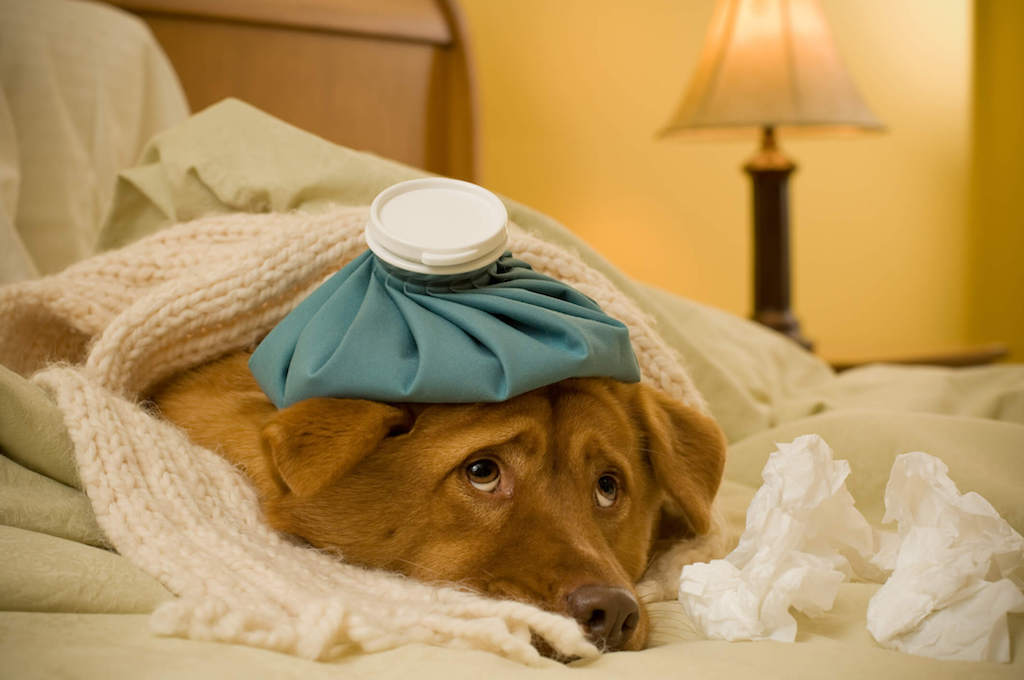
Again, though, every dog is different. Some may experience no reaction or a severe reaction from mold in dog food.
How Does Mold in Dog Food Happen?
At this point, you may be a little freaked out and thinking, “Okay, so which brands do I steer clear of?” The truth is, there’s no hard rule for which brands or types to avoid.
There are certain regulations from the FDA for levels of mycotoxins in pet food products, like the aflatoxin found in Midwestern Pet Foods products, but that list is limited.¹⁶ While we usually only hear about “toxic mold” or “mycotoxins,” any mold exposure has the potential to cause allergic reactions. Yes, some are definitely more prone to causing illnesses, either from inherent toxicity or by producing toxic byproducts, but mold spores and particles are still foreign particles the immune system has to fight off.
With dog food being fairly easily susceptible to mold growth, you just never know what will cause him or her symptoms. The first step toward providing healthy and safe food for your pet is to understand the stages at which mold in dog food can occur.
In The Ingredients
In no way shape or form am I delving into the “what’s best for your dog” argument when it comes to food! Pet parents are just as choosy and dedicated to their nutritional beliefs as human child parents. However! Whatever that diet may be, when you look at the back of the bag or can, what are the main ingredients you often see for dog food? Typically, it’s a source of protein, followed by carbohydrates, grains, fruits, and vegetables.
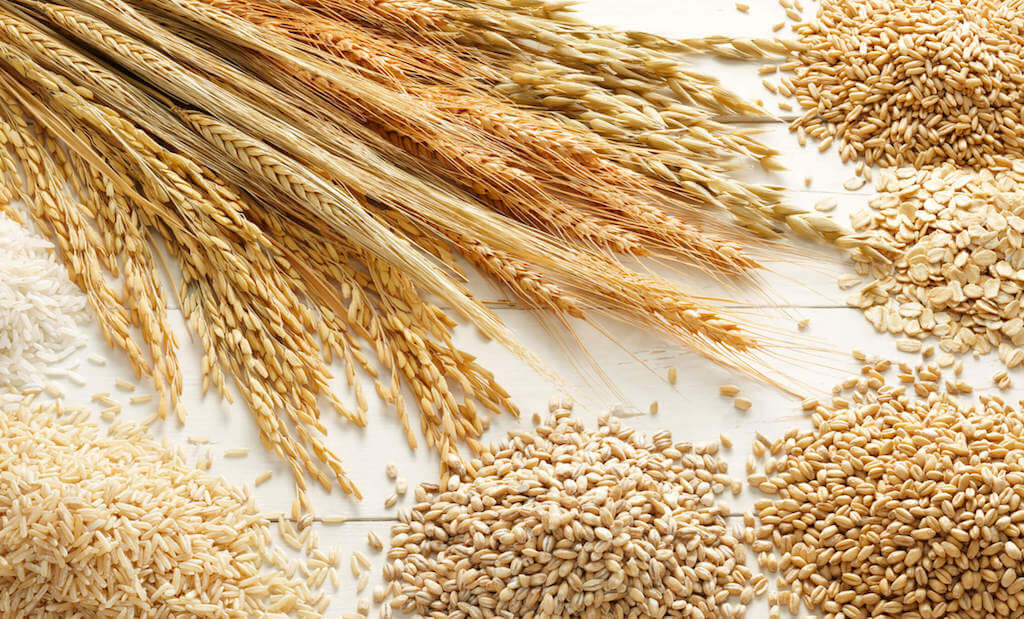
That sounds pretty nutritious and delicious! Mold happens to love the same ingredients that dogs enjoy, though. Between the growing phase, storage, and treatment process, mold spores can come into contact with the plant-based components of dog food. Depending on the moisture level in each situation, they can settle in and begin to grow right on plant. Corn and grains, two popular ingredients in dog food, are particularly susceptible to and known for mold growth. To make matters slightly worse, who else eats corn and grain products? Livestock like cattle and chickens, which happen to be two of the main proteins in dog food.
Again, the FDA regulates certain levels of mycotoxins in these goods, but there could be a number of toxins and molds in these products at a lower concentration and we’d never know. The true invisible threat. When you factor in how many of these products are components of the food your dog eats every day, it’s easy to see how just the initial ingredients stage can cause mold in dog food. This leads to mold and mycotoxin exposure for your dog and all of the potential side effects that go along with it.
In The Production
Like the treatment plants for base ingredients, like grains, dog food manufacturing plants can also be held accountable for introducing mold and its byproducts to the finished product. Or not identifying a surplus of existing mold from the growing stage.
Several factors go into keeping food products mold-free while in manufacturing plants. Products stored improperly can have too much moisture and allow for mold growth. Improper cleaning can leave behind food sources and potentially habitable areas for mold growth. Colonized mold in a manufacturing plant is a problem because it leads to a higher volume of spores inside the building, which can then opportunistically begin growing on whatever small water source they come into contact with. Additionally, improper or insufficient testing to detect mold or mycotoxin presence during the harvesting phase can result in continued growth and high contamination levels in food products. Even packaging and storing finished products incorrectly can lead to mold in pet food.
Frank Coch, Executive VP of Marketing for Natural Balance Pet Foods said, “When the moisture in a bag of dry pet food exceeds 10%, mold can develop on the food in the bag.”
The list goes on of potential situations that could allow mold in dog food while at production plants. That is why it’s important for these companies to actively take steps to become more aware of mold and mold exposure health effects as well as prevent it both in the plant, in the ingredients, and in the final product.
In The Home
Moldy dog food can also happen right there in your own home. There are a few ways mold spores can take an open invitation for growth.
Have you ever considered where you store your dog food? The main priority is probably to keep it out of sight or away from your sneaky fur child that never seems to actually get full.
Keep in mind how mold grows, though! All it takes is one mold spore and a bit of moisture for colonization to begin within your dog’s food. Wet food, in particular, is even more prone to growth because, well, the moisture component is right there in the name.
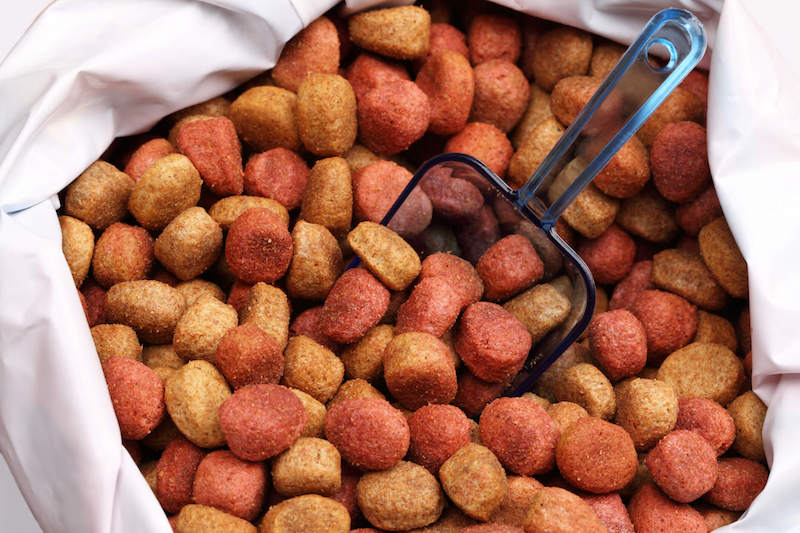
Also, don't forget to consider the dog container as well. When’s the last time that thing was even washed…? Or the scoop? It always manages to slip the mind during cleaning day, like bad magic. Cleaning isn't the only component to ponder. Is it air tight? Where is it located? Do you keep the food in the bag and place that into the container?
All of these components are important to help discourage mold in dog food and keep it safe and healthy for your pet.
Finally, the expiration date is incredibly important! Like regular food products, dog food that’s past its expiration date can be a hot location for not only mold growth, but bacteria as well.
Avoiding Mold in Dog Food
Like the inability to 100 percent avoid mold exposure in an outdoor or indoor environment, it’s impossible to completely eliminate every mold spore and toxin from your dog’s food. A rogue spore could have slipped in and landed inside the bag as you were safely putting it away. That being said, mitigation and mold prevention are the name of the game to keep your fur baby healthy and happy.
Some steps you can start taking to stop mold in dog food for your pet are:¹⁷
- Research what your favorite brand is doing to minimize mold growth and mycotoxins in their food products. They should understand how important it is for your dog’s health and proactively take steps to eliminate it so your pup stays healthy.
- Focus on proper storage. This includes keeping it in a dry (not humid), cool space with a non-fluctuating temperature. When the temperature repeatedly transitions from hot to cold, moisture can build up inside the bag on the food. More moisture means happy mold spores.
- Speaking of storage, make sure you’re using the right container! An airtight container will help keep moisture and humidity out of dry dog food, as well as any rogue spores or toxins. Also, make sure to keep the dry dog food in the bag. It’s an added layer of protection for the food and ensures you have access to all of the brand’s information and the expiration date.
- Keep an eye on the expiration date and the “use by X date after opening” manufacturer suggestions. Old food can quickly become moldy food.
- Don’t put new food on top of the old food. For the super proactive pet parents out there who don’t wait until the very last kibble bit is gone to buy food, make sure that you’re not throwing that new bag on top of the old food! That leads to expired food at the bottom and more moldy opportunities.
- Wash food containers and scoops frequently and food bowls even more often (daily is best).
- Make sure to look carefully at the food before placing it in front of your dog. If it smells off or looks moldy toss it out asap!
- If your dog refuses food, don’t become an angry doggo parent! They could smell that something’s off with their food using their super-powered sniffer. Instead, try to feed them another can or attempt a different time. If they still refuse, try a brand new bag or can from the store.
- Pay attention to how your dog reacts after eating. They'll be your best indicator that something isn’t right! If they start to get sick or aren’t acting like themselves, it could be an issue with the food itself, which might mean you have a mold problem.

Making Sure Your Fur Baby Is Mold-Free
Being a dog parent is filled with joy and more than a few laughs, but it can be stressful! Like human children, you’re primarily responsible for their continued health and happiness. The endless products, suggestions, and opinions out there also don’t make it any easier.
While mold may not be on the top of the list for concerns, it can sneak in and begin affecting your dog’s health.
That makes it a serious parental enemy! By increasing our mold awareness and actively taking steps to avoid mold in dog food, we can ensure that our canines stay healthy and carefree. A happy dog 1000% makes a happy home (and dog owner)!
- Tyko, K. (2021, July 30). Dog Food sold nationwide recalled due to potentially high levels of aflatoxin, a mold byproduct. USA Today. Retrieved October 14, 2021, from https://www.usatoday.com/story/money/shopping/2021/07/29/dog-food-recall-sunshine-mills-evolve-aflatoxin-mold-elevated-levels/5419522001/.
- Fischels, J. (2021, August 18). The FDA suspects Tainted Pet Foods poisoned hundreds of dogs. NPR. Retrieved October 14, 2021, from https://www.npr.org/2021/08/18/1029067086/dogs-poisoned-fda-midwestern-per-foods-recalled.
- Center for Veterinary Medicine. (2021, August 9). Midwestern Pet Food. U.S. Food and Drug Administration. Retrieved October 14, 2021, from https://www.fda.gov/inspections-compliance-enforcement-and-criminal-investigations/warning-letters/midwestern-pet-food-613845-08092021.
- Environmental Protection Agency. (n.d.). Mold. EPA. Retrieved August 17, 2021, from https://www.epa.gov/mold.
- Centers for Disease Control and Prevention. (2020, August 11). Basic facts about mold and dampness. Centers for Disease Control and Prevention. Retrieved August 17, 2021, from https://www.cdc.gov/mold/faqs.htm.
- World Health Organization. (n.d.). Mycotoxins. World Health Organization. Retrieved August 26, 2021, from https://www.who.int/news-room/fact-sheets/detail/mycotoxins.
- Lstiburek, J., Brennan, T., & Yost, N. (2002, January 15). Rr-0208: What you need to know about mold. Building Science Corporation. Retrieved August 18, 2021, from https://www.buildingscience.com/documents/reports/rr-0208-what-you-need-to-know-about-mold/view.
- Bush, R. K., Portnoy, J. M., Saxon, A., Terr, A. I., & Wood, R. A. (2006). The medical effects of mold exposure. Journal of Allergy and Clinical Immunology, 117(2), 326-333
- Environmental and Occupational Health Assessment Program, & Environmental and Occupational Health Assessment Program, & Health Science Section, Mold Basics for Primary Care Clinicians (2009). Hartford, CT; Connecticut Department of Public Health. , H. S. S., Mold Basics for Primary Care Clinicians 1–10 (2009). Hartford, CT; Connecticut Department of Public Health.
- Boermans, H. J., & Leung, M. C. (2007). Mycotoxins and the pet food industry: toxicological evidence and risk assessment. International journal of food microbiology, 119(1-2), 95-102.
- Fink‐Grernmels, J. (1999). Mycotoxins: their implications for human and animal health. Veterinary Quarterly, 21(4), 115-120.
- Atungulu, G. G., Mohammadi-Shad, Z., & Wilson, S. (2018). Mycotoxin issues in pet food. Food and feed safety systems and analysis, 25-44.
- Böhm, J., Koinig, L., Razzazi-Fazeli, E., Blajet-Kosicka, A., Twaruzek, M., Grajewski, J., & Lang, C. (2010). Survey and risk assessment of the mycotoxins deoxynivalenol, zearalenone, fumonisins, ochratoxin A, and aflatoxins in commercial dry dog food. Mycotoxin Research, 26(3), 147-153.
- Pier, A. C., Richard, J. L., & Cysewski, S. J. (1980). Implications of mycotoxins in animal disease. Journal of the American veterinary medical association, 176(8), 719-724.
- Hughes, D. M., Gahl, M. J., Graham, C. H., & Grieb, S. L. (1999). Overt signs of toxicity to dogs and cats of dietary deoxynivalenol. Journal of animal science, 77(3), 693-700.
- Medicine, C. for V. (2021, July 7). Chemical Hazards. U.S. Food and Drug Administration. Retrieved October 14, 2021, from https://www.fda.gov/animal-veterinary/biological-chemical-and-physical-contaminants-animal-food/chemical-hazards.
- Center for Veterinary Medicine. (2020, April 4). Proper Storage of Pet Food & Treats. U.S. Food and Drug Administration. Retrieved October 14, 2021, from https://www.fda.gov/animal-veterinary/animal-health-literacy/proper-storage-pet-food-treats.

